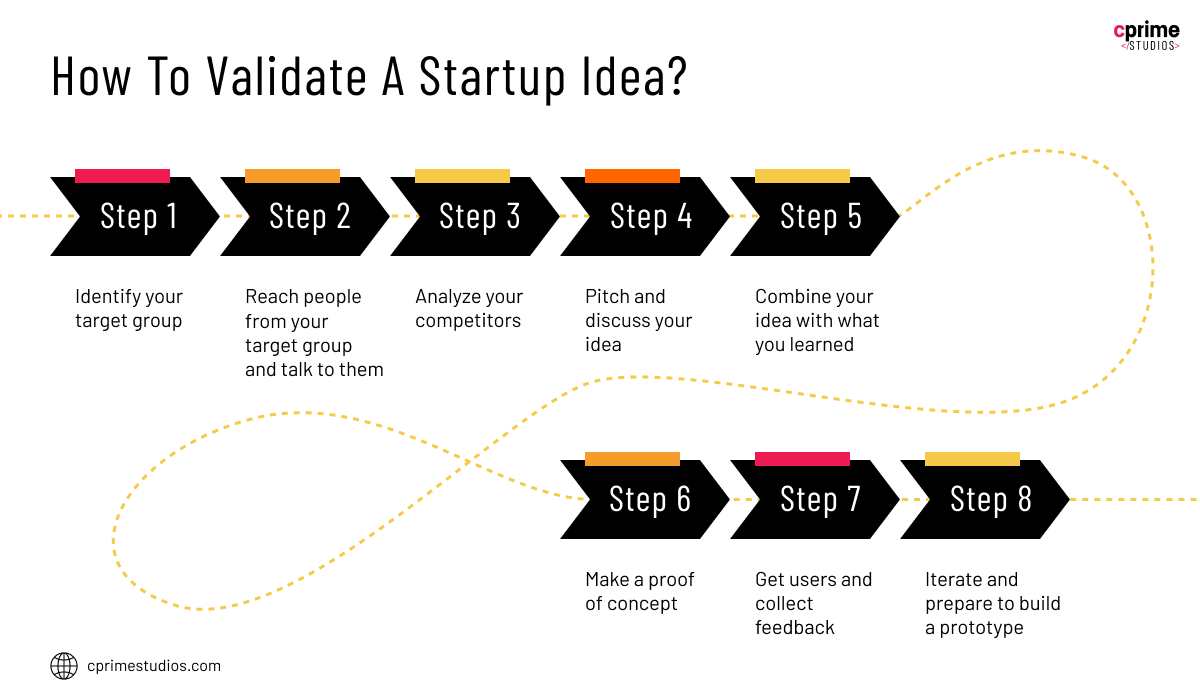6 Techniques to Validate a Startup Idea
In the real world, you need to know how to validate startup idea to win the fierce competition between many digital products. Without that, the young startup risks failing even when the offer seems to sound perfect from the start. We gathered 6 methods that will help you avoid the pitfalls and run a successful product.
Ideal conditions for the development of online businesses have led to the number of startups growing exponentially in recent years. However, most of them fail either immediately or in their first year of existence.
Why does this happen? Start-up initiators might make the mistake of considering their idea a winner without prior analysis, strategy development, or at least minimal management. They might believe that everything will work by itself, and they are mistaken. In this article, we want to offer you a more reasonable and scientific approach to testing business ideas using five methods.
1. LEAN STARTUP
This approach can be summed up in one sentence – do not invest until you are sure of the result. The author of the Lean Startup approach calls to first create a minimally viable product and test your business idea on a live audience. This will help evaluate the demand for the idea with minimal investment. If the idea is in demand, then real market validation is a source of valuable information about what users like or not, and what they expect from your product.
After receiving this information, the startup gets the opportunity to quickly adapt to the needs of the user and make changes to the product or strategy before a large amount has been invested.
Then, they can make more stables moves from the minimum set of necessary functions to gradual scaling and bringing the product to perfection according to the needs of the target audience.
2. F.O.C.U.S
Focus groups are especially effective when it is necessary to identify people’s perceptions, feelings, and thoughts about any problems, products, services, or opportunities.
When developing a product, focus groups are used in three stages:
-
- At the first stage, focus groups are used to better understand the issue; that is, to look at it through the eyes of representatives of the target audience.
- In the second stage, this information is used to create a minimally viable product. It is possible to create several products with different sets of functions for further validation.
- In the third stage, after receiving the results of pilot testing in focus groups, the best version of the product is created, which will be released to the market.
Focus groups can provide useful information even after the initial stages of starting a business. They are used for evaluation.
This customer-oriented method is used to know if your business idea will work and can only be used in conjunction with methods for assessing external factors as well.

3. GOOGLE DESIGN SPRINTS
Google Design Sprints is an approach that is ideal for team brainstorming. Its goal: for a startup idea validation you need to generate the maximum number of useful ideas at each stage of product development. Here is the algorithm for conducting this type of analysis:
- Understanding. What does the user want to see in the product?
- Definition. What is the main goal of the project?
- Divergence. Generating the maximum amount of ideas.
- Making decisions. Clarify everything.
- Prototyping. Recall the Lean Startup method – at this stage, it is necessary to create a minimally viable product to test your hypotheses on real users.
- Validation. The process of getting feedback and confirming your ideas.
4. MICHAEL PORTER’S FIVE FORCES MODEL
Michael Porter’s five forces model is suitable for analyzing the environment in highly competitive niches. This approach is maximally aimed at identifying external threats and risks. In its framework, it is necessary to analyze the following indicators:
- The entry of competitors. Is it easy to enter this niche?
- The threat of substitutes. How easy is it to replace your offer with a cheaper or more profitable one?
- Bargaining power of buyers. In other words, how much money they have.
- Bargaining power of suppliers. Are there many potential suppliers?
- Competition among existing players. How are the forces distributed in the niche?
The results of this study can be well used for the SWOT analysis, which we will discuss later on.
5. PEST
This is a good method to coordinate in the environment in which the business will operate. PEST categories include political, economic, social, and technological factors. It is possible to add environmental and legal categories as well.
PEST not only identifies significant environmental factors but also analyzes the strength of their impact on the business. The result is a matrix that reflects significant factors. Each factor gets its quantitative assessment.
PEST analysis is used in assessing the current strategic status of a company, in developing and monitoring the implementation of a strategy, launching an investment project, entering new markets, and analyzing ideas from scratch as well.
It is important to note that PEST analysis can only be used in combination with other analysis methods since it takes into account only external factors. In the meantime, testing business idea itself and the potential response among the users remains essential.
6. SWOT
SWOT is one of the most well-known business testing methods. Its essence is to assess its strengths and weaknesses, as well as to identify opportunities and threats. In this case, both internal and external factors are taken into account. This approach is ideal for strategic planning. Let’s take a look at the SWOT analysis example of creating a taxi booking application to understand how to validate startup idea:
- Strengths. For example, you offer customers trips out of town for the price of city trips.
- Weaknesses. For example, at first, your application will be available only for Android.
- Opportunities. For example, studies have shown that a certain segment of users began to use taxis more often than they did before.
- Threats. For example, one of the existing competitors began to pursue an aggressive market conquest policy.
As you can see, SWOT opportunities allow you to get a comprehensive picture and evaluate all the possible factors. The most important thing is to try to remain extremely objective.
CONCLUSION
Each of the above methods of analyzing business ideas is effective and can be used for almost any industry. It would be wise to take advantage of each method before deciding whether to develop a product.
Just as well, the Cprime team will be happy to discuss any of your ideas, give tips on which technologies are better to use, and create a cool solution for your business needs!
Contact us at learn@cprime.com to learn more.


